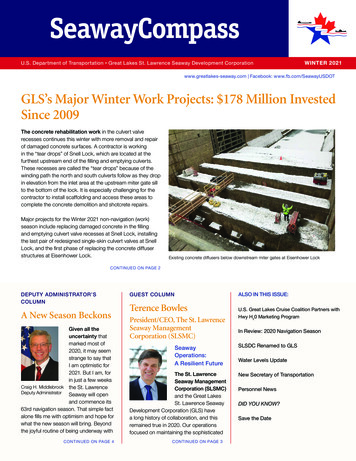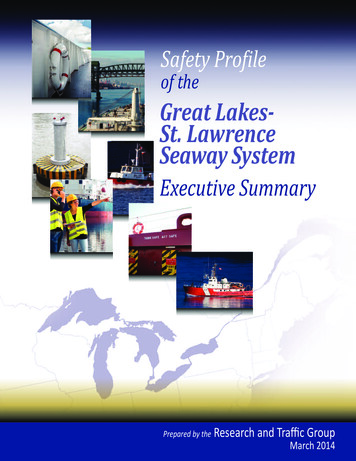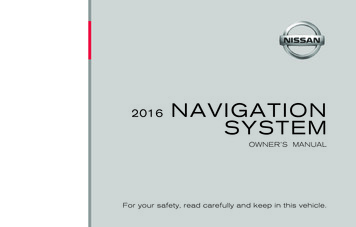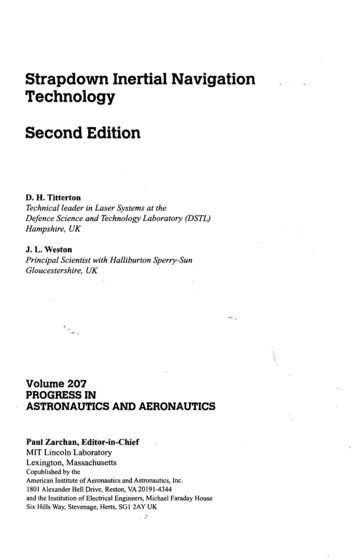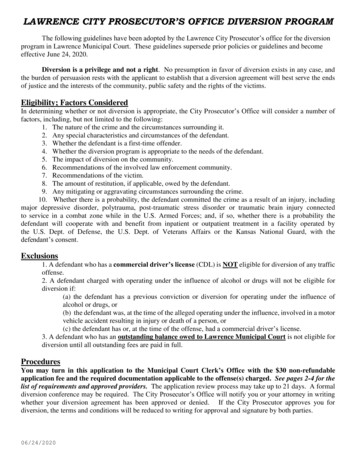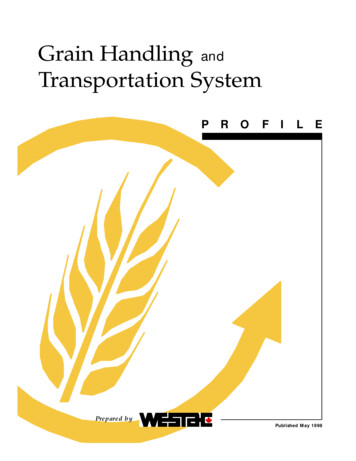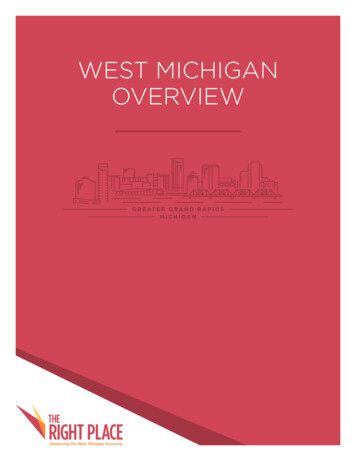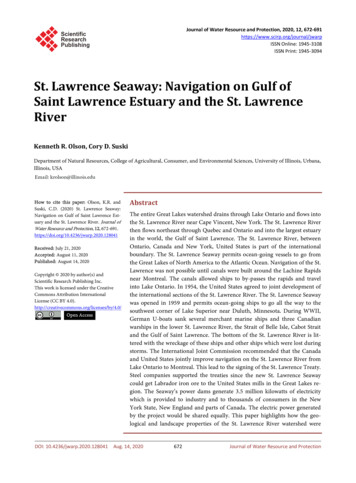
Transcription
Journal of Water Resource and Protection, 2020, 12, 672-691https://www.scirp.org/journal/jwarpISSN Online: 1945-3108ISSN Print: 1945-3094St. Lawrence Seaway: Navigation on Gulf ofSaint Lawrence Estuary and the St. LawrenceRiverKenneth R. Olson, Cory D. SuskiDepartment of Natural Resources, College of Agricultural, Consumer, and Environmental Sciences, University of Illinois, Urbana,Illinois, USAHow to cite this paper: Olson, K.R. andSuski, C.D. (2020) St. Lawrence Seaway:Navigation on Gulf of Saint Lawrence Estuary and the St. Lawrence River. Journal ofWater Resource and Protection, 12, eceived: July 21, 2020Accepted: August 11, 2020Published: August 14, 2020Copyright 2020 by author(s) andScientific Research Publishing Inc.This work is licensed under the CreativeCommons Attribution InternationalLicense (CC BY en AccessDOI: 10.4236/jwarp.2020.128041AbstractThe entire Great Lakes watershed drains through Lake Ontario and flows intothe St. Lawrence River near Cape Vincent, New York. The St. Lawrence Riverthen flows northeast through Quebec and Ontario and into the largest estuaryin the world, the Gulf of Saint Lawrence. The St. Lawrence River, betweenOntario, Canada and New York, United States is part of the internationalboundary. The St. Lawrence Seaway permits ocean-going vessels to go fromthe Great Lakes of North America to the Atlantic Ocean. Navigation of the St.Lawrence was not possible until canals were built around the Lachine Rapidsnear Montreal. The canals allowed ships to by-passes the rapids and travelinto Lake Ontario. In 1954, the United States agreed to joint development ofthe international sections of the St. Lawrence River. The St. Lawrence Seawaywas opened in 1959 and permits ocean-going ships to go all the way to thesouthwest corner of Lake Superior near Duluth, Minnesota. During WWII,German U-boats sank several merchant marine ships and three Canadianwarships in the lower St. Lawrence River, the Strait of Belle Isle, Cabot Straitand the Gulf of Saint Lawrence. The bottom of the St. Lawrence River is littered with the wreckage of these ships and other ships which were lost duringstorms. The International Joint Commission recommended that the Canadaand United States jointly improve navigation on the St. Lawrence River fromLake Ontario to Montreal. This lead to the signing of the St. Lawrence Treaty.Steel companies supported the treaties since the new St. Lawrence Seawaycould get Labrador iron ore to the United States mills in the Great Lakes region. The Seaway’s power dams generate 3.5 million kilowatts of electricitywhich is provided to industry and to thousands of consumers in the NewYork State, New England and parts of Canada. The electric power generatedby the project would be shared equally. This paper highlights how the geological and landscape properties of the St. Lawrence River watershed wereAug. 14, 2020672Journal of Water Resource and Protection
K. R. Olson, C. D. Suskiresponsible for the successful economic development of this important andhistorically-rich region of North America. Planned economic and urban development of the St. Lawrence River basin by USACE was blocked by the“Save the River” campaign. Environmental challenges include disposal oftreated and untreated wastewater, water pollution, and shore erosion, invasive species and flooding.KeywordsInvasive Species, Lake Champlain, Newfoundland, Shore Erosion, WaterPollution1. IntroductionThe St. Lawrence River watershed and Newfoundland located in Canada arecurrently home to millions of people. The development of this area by Europeans has roots that extend back thousands of years, and is intimately connectedto the St. Lawrence basin and the eventual development as the St. LawrenceSeaway [1].The St. Lawrence River flows 3058 km in a northeastern direction from LakeOntario to the Atlantic Ocean (Figure 1) [1]. The headwater is the North Riverin the Mesabi Range at Hibbing, Minnesota [2], and the entire Great Lakes drainage basin discharges into the St. Lawrence River near Cape Vincent, New York.Figure 1. The Great Lakes and St. Lawrence River watershed. Map by Mic Greenberg.DOI: 10.4236/jwarp.2020.128041673Journal of Water Resource and Protection
K. R. Olson, C. D. SuskiThe St. Lawrence River begins at eastern end of Lake Ontario and drains to thenortheast and into the Gulf of Saint Lawrence, the largest estuary in the world(Figure 2). The river is part of the international boundary between Ontario,Canada and New York, United States, flowing through the Canadian provincesof Quebec and Ontario [3]. The drainage area totals 1,344,200 km2 with morethan 60% in Canada and 40% in the United States.The St. Lawrence Seaway is a maze of canals, locks (Figure 3), and channels inthe United States and Canada [2]. The Seaway permits ocean-going vessels totravel from the Atlantic Ocean to the Great Lakes of North America, as far westas Lake Superior. The Seaway is named for the St. Lawrence River. The WellandCanal (Figure 4) connects Lake Ontario to Lake Erie and permits Ocean goingships to bypass the Niagara Escarpment and Niagara Falls (Figure 5).The St. Lawrence lowlands are plains adjacent to the St. Lawrence River between Brockville, Ontario in the west and Quebec City in the east. The lowlandsinclude the Ottawa River valley west to Renfrew, Ontario. The topography of thelowlands is the result of weathering and erosion by rivers of the flat-lying sedimentary rock. The total lowland area is 46,000 km2 with 5000 km2 in the UnitedStates. It is 450 km long and 100 km wide in the west but narrows to 35 km inQuebec with an arm extending 130 km south into the Lake Champlain Valley(Figure 6). The lowlands were occupied by the Iroquoian-speaking people atthe time of discovery by Jacques Cartier in 1535. The farmlands wereFigure 2. Newfoundland, the Gulf of St. Lawrence, the Strait of Belle Isle and CabotStrait. Mic Greenberg.DOI: 10.4236/jwarp.2020.128041674Journal of Water Resource and Protection
K. R. Olson, C. D. SuskiFigure 3. The Iroquois lock and control dam which controls the level of Lake Ontario.Picture taken by Lois Wright Morton.Figure 4. The Welland canal which permitted ocean going ships to by-pass the NiagaraEscarpment and Niagara Falls.Figure 5. Niagara Falls and the Niagara Escarpment.DOI: 10.4236/jwarp.2020.128041675Journal of Water Resource and Protection
K. R. Olson, C. D. SuskiFigure 6. The Lake Champlain, Richelieu River and Chambly Canal and river watershed.Map by Mic Greenberg.settled in a pattern of narrow strips fronting the river [1]. Industry began nearTrois-Rivieres where bog iron was exploited in 1757. Most of the Quebec population lives on the St. Lawrence River Valley lowlands.The primary objectives of the paper are: 1) to document the geological andlandscape properties of the St. Lawrence River basin has contributed to the successful resource and economic development of a historically-rich region ofNorth America and 2) to document the environmental and natural resourcerisks to the St. Lawrence River basin and the Gulf of Saint Lawrence estuary.These environmental challenges include the settlement of millions of people inthe St. Lawrence River basin, navigation of the St. Lawrence River, disposal oftreated and untreated wastewater, water pollution, shore erosion as a result ofhigh water levels in the Great Lakes and connecting rivers, invasive species, andflooding.DOI: 10.4236/jwarp.2020.128041676Journal of Water Resource and Protection
K. R. Olson, C. D. Suski2. Study Site2.1. Geological History of St. Lawrence River BasinThe Laurentide Ice Sheet was massive and covered millions of square kilometersincluding a large portion of northern United States and much of Canada. Themassive sheet occurred many times during Quaternary glacial epochs—from2.588 0.005 million years ago to the present. The last advance covered most ofNorth America between 95,000 BP and 20,000 years BP [4]. The effects of theglacier included the gouging out of the five Great Lakes and other smaller lakesof the Canadian Shield [2]. These lakes included Lake Champlain, Lake Georgeand the Finger Lakes of New York State.The ice sheet was up to 3.2 km thick in the center and much thinner at theedges. It caused many changes to the shape, size, and drainage of the Great Lakesbasin near the end of the last ice age. Lake Iroquois extended beyond the boundaries of the present day Lake Ontario. Lake Iroquois drained through the Mohawk [5] and Hudson Rivers to the Atlantic Ocean. The ultimate collapse of theLaurentide Ice Sheet is also suspected to have influenced European agriculturethrough the rise of sea levels. Labrador ice flowed into the Gulf of Saint Lawrence completely covering the Maritime Provinces of Canada.The details of the lowland’s present landscape are the result of the last continental glaciation. Glaciation was followed by marine submergence, emergenceand river erosion and deposition. Earlier glacial evidence was often removed bylater glacial events. These glacial events were separated by a non-glacial intervalduring which peat and lake sediments accumulated. The last interval ended70,000 to 34,000 years ago. Deposits exposed in valleys near Lac Saint-Pierre indicated an early interval of weathering and deposition of river gravels followedby 2 or more glacial events [1].The last major glacial advance was 18,000 years ago. These ice sheets intermittently uncovering the south and southwestern parts of lowlands. These uncovered sections were inundated by post-glacial lakes. The residual glacial icenear Quebec obstructed the St. Lawrence Valley until 13,000 years ago when theice disintegrated. From 13,000 to 10,000 years ago the St. Lawrence Lowland roserapidly (up to 0.2 m per year) in response to the melting of the heavy ice massand subsequent runoff [1]. The relict strand lines of the Champlain Sea on thenorth side are at 330 m and only 255 m on the south side.The sea, with a surface at 40 m above current sea level, withdrew 9,500 yearsago and occupied the central part of the basin. It drained when the St. LawrenceRiver eroded its channel past Quebec about 6500 years ago. The Paleozoic sediment rocks (sandstone, dolomite, limestone and shale) are 520 to 480 millionyears old [4]. The lowland is part of a rift valley originating in historical (Cretaceous) times and is a region of high earthquake probability where major damagecan be expected.The Champlain Valley is the northernmost unit of a landform known as theGreat Appalachian Valley. The Champlain Valley is a physiographic section ofDOI: 10.4236/jwarp.2020.128041677Journal of Water Resource and Protection
K. R. Olson, C. D. Suskithe St. Lawrence Valley. Lake Champlain is in the Lake Champlain Valley(Figure 6) between the Green Mountains of Vermont and the AdirondackMountains of New York which drain northward by the 171 km Richelieu River(Chambly Canal) to the St. Lawrence River at Sorel-Tracy, Quebec, northeastand downstream of Montreal. It also receives water from the 51 km long LakeGeorge. Approximately 250,000 people get their drinking water from LakeChamplain. It is connected to the Hudson River by the Champlain Canal, whichis part of the New York State Canal system [5]. Parts or all of Lake Champlainfreeze each winter.2.2. Newfoundland SoilsThe Newfoundland landscape is a mixture of bogs, rock outcrops, barrens, waterbodies (Figure 7) and mineral soils. Much of the interior of the island portion ofthe province is covered by extensive bogs and barren lands. These sparsely forested heather and mass barrens result from wind exposure, humid conditions,temperature limitations and soil conditions. The soils on the uplands are coarse,usually quite stony, have firm to compact subsoil and are usually very shallow[6].The natural vegetation, boreal forest which surrounds the barrens is dominantly coniferous species including spruce and broad-leaved deciduous treessuch as birch. The deeper and more favorable soils are usually found on elevatedridges, on coastal lowlands and along river terraces. Newfoundland soils are veryacid, and low fertility is the dominant soil limitation to crop growth. The soilsrequire lime and fertilizer to supplement elements necessary for plant growth.Another major limitation is stoniness, which creates management problems andincreases the cost of land clearing. Wet soils need to be drained prior to agriculturalFigure 7. The Bonne Bay community out letting into the Gulf of Saint Lawrence. Picturetaken by Lois Wright Morton.DOI: 10.4236/jwarp.2020.128041678Journal of Water Resource and Protection
K. R. Olson, C. D. Suskiuse. Compacted subsoil layers resist root penetration and slow rainfall percolation. Steep slopes and complex topography prevent the use of farm machineryand create an erosion hazard.The Newfoundland Exploratory Soil Survey Program ended in the mid-1990sand was the basis for the Canada Land Inventory Soil Capability Mapping [6].The exploratory soil survey provided critical data for planning long term agricultural priorities. A detailed soil survey of Newfoundland was needed to provide soil information to guide agriculture use to the most suitable areas, and alsofor land management planning.2.3. Gulf of Saint LawrenceThe Gulf of Saint Lawrence is the outlet for the North American Great Lakeswater (Figure 2) via the St. Lawrence River. The gulf is a semi-enclosed sea,covering about 226,000 km2 of area with 34,500 km3 of water, and having an average depth of 152 m [3]. The Gulf of Saint Lawrence adjoins the provinces ofNew Brunswick, Nova Scotia, Prince Edward Island, Newfoundland and Labrador and Quebec. Seven major rivers flow into the Gulf of Saint Lawrence including St. Lawrence River, Miramichi River, Natashquan River, Romaine River,Restigouche River, Margaree River and the Humber River. There are 7 bays, andthe Gulf of Saint Lawrence flows into the Atlantic Ocean through 3 outlets, theStrait of Belle Isle, the Cabot Strait (Figure 8), and the Strait of Cansoc.2.4. Strait of Belle IslandThe Strait of Belle Isle is a waterway in eastern Canada that separates the Labrador Peninsula and the island of Newfoundland (Figure 2). The strait is thenorthern outlet for the Gulf of Saint Lawrence and is considered part of theFigure 8. The Gulf of Saint Lawrence estuary at the Port of Basqusat on Newfoundlandnear the Cabot Strait and the Laurentian Channel.DOI: 10.4236/jwarp.2020.128041679Journal of Water Resource and Protection
K. R. Olson, C. D. SuskiGreat Lakes-St. Lawrence Seaway system. The strait is 125 km long and ranges inwidth from 15 to 60 km. Navigation in the strait [7] can be extremely hazardouswith the Labrador Current interacting with strong tidal currents. Depths canreach several hundred meters. Sea ice is present for 8 to 10 months with galeforce winds and fog. The sea ice prevents year-around shipping. A ferry serviceoperates in the western part of the strait between St. Barbe, Newfoundland andBlac Sablong, Quebec (Figure 2).2.5. Cabot StraitCabot Strait is located between Cape Ray, Newfoundland and Cape North, CapeBreton Island. It is the widest of 3 outlets for the Gulf of St. Lawrence into theAtlantic. The other outlets are the Strait of Belle Isle and Strait of Canso. TheLaurentian Channel is a deep trench in the Cabot Strait (Figure 8) with theshallow coastal waters closer to Newfoundland and Cape Breton Island. Thesedepth changes in Cabot Strait have caused rogue waves. The strait was a strategically important waterway all throughout the history of both Canada and Newfoundland. The strait is an important international shipping route [7], being theprimary waterway link between the Atlantic and the Great Lakes and St. Lawrence Seaway. The Cabot Strait has a maximum depth of 550 m over the Laurentian Channel. The maximum length of the Cabot Strait is 37 km and the maximum width is 130 km.2.6. Laurentian ChannelThe Laurentian Channel is a deep trench in the Cabot Strait and a deep submarine valley off the coast of eastern Canada in the Gulf of Saint Lawrence (Figure2). The channel is of glacial origin and is the submerged valley of the historic St.Lawrence River, running 1400 km from the confluence of the St. Lawrence Riverwith the Saguenay River. It runs past Anticosti Island and through the Gulf ofSaint Lawrence to the edge of the continental shelf off the island of Newfoundland. The historic Laurentian fan is located at the edge of the continental shelf.The channel depth ranges from 180 to 550 m with shallow sub-tidal shelves oneach side of the channel ranging in depths of less than 100 m. The LaurentianChannel has a minimum width of 10 km and can be as much as 55 km wide. Thesteep slope of the Laurentian Channel was the site of a 1929 Grand Banks earthquake which created a tsunami that destroyed communities in Newfoundlandand Cape Breton Island.2.7. NewfoundlandNewfoundland is a large Canadian island of the east coast of North America(Figure 2). This island blocks the mouth of the St. Lawrence River creating theworld’s largest estuary, the Gulf of Saint Lawrence. Newfoundland is the world’s16th largest island with an area of 108,860 km2. The first inhabitants of Newfoundland were the Paleo-Eskimo. The island was settled by indigenous peoplesDOI: 10.4236/jwarp.2020.128041680Journal of Water Resource and Protection
K. R. Olson, C. D. Suskiof the Dorset culture about 4,000 years ago. It was visited by Leif Eriksson, anIcelandic Viking, in the 11th century who call the island Vineland (Figure 9).The next Europeans to come were the Basque, Spanish, Portuguese, French andEnglish migratory fishermen and whalers [1].Sir Humphrey Gilbert claimed Newfoundland as England’s first overseas colony in 1583 under Royal Charter of Queen Elizabeth I of England. Newfoundland is the British Empire’s oldest colony. The site is one of the earliest meetingsof the Old World and the New World. At the time of English settlement theBeothuk who had migrated from Labrador, occupied the island since the time ofNorse visits. L’Anse aux Meadows was a Norse settlement (Figure 10) near thenorthernmost tip of Newfoundland and dated 1000A.D. [1].Figure 9. The Norse settlement site (1000AD) near St. Antony and adjacent to AtlanticOcean. The building sites appear as raised ridges. The site is now L’Anser aux MeadowsNational Historic Site. Picture taken by Lois Wright Morton.Figure 10. The building site appears as a recreated sod hut. The site is now L’Anser auxMeadows National Historic Site. Picture taken by Lois Wright Morton.DOI: 10.4236/jwarp.2020.128041681Journal of Water Resource and Protection
K. R. Olson, C. D. SuskiThe Norse (Leif Eriksson) explored the Gulf of Saint Lawrence in the 11thcentury (Figure 11), and European mariners (John Cabot, Gaspar brothers, Miguel Corte-Real, and Alonso Sanchez) in the 15th and early 16th century. In 1535Jacques Cartier, was the first European explorer known to have sailed the St.Lawrence River. The Basques were the first Europeans to fish and hunt whaleson the St. Lawrence River and Gulf of Saint Lawrence and to set up settlementsand trade with the indigenous Americans. Basque commercial and fishing activity reached its peak in 1588. The Spanish destroyed most of the Basque whalingfleet in 1588. In the 17th Century the French controlled the St. Lawrence Riverand adjacent lowlands. In 1758 the British captured New France during the Seven Year’s War [1].Because of Lachine Rapids (Figure 12), which were impassable, the St. Lawrence was only navigable as far west as Montreal (Figure 13). In 1829, the Lachine Canal completion allowed ships to pass through the rapids. An extensivesystem of locks and canals, the St. Lawrence Seaway was officially opened on 26June 1959 by Elizabeth II representing Canada and President Dwight D. Eisenhower representing the United States. The St. Lawrence Seaway permitsocean-going ships to travel all the way to the southwest corner of Lake Superior[2].During WWII between 1942 and 1944, German U-boats sank several merchant marine ships and three Canadian warships in the lower St. Lawrence River, the Strait of Belle Isle and Cabot Strait and the Gulf of Saint Lawrence. Manyof these sunken ships still lie on the river and estuary floor with varying environmental impacts depending on the cargo and any recovery operations.During the 1970s and after more than 150 years of successful resource andFigure 11. The monument that Norway gave Canada to recognize the Norsemen tradingpost at L’Anser aux Meadows National Historic Site. Picture taken by Lois Wright Morton.DOI: 10.4236/jwarp.2020.128041682Journal of Water Resource and Protection
K. R. Olson, C. D. SuskiFigure 12. Montreal harbor located just east and down river from the Lacline Rapids.Picture taken by Lois Wright Morton.Figure 13. A cruise ship on the St. Lawrence River canal near Montreal.economic development of the St. Lawrence Basin a grass roots challenge of theproposed United States Army Corps of Engineers (USACE) planned development of the St. Lawrence River was blocked by a successful ecological campaigncalled “Save the River”. Save The River is a member of the Waterkeeper Allianceas the Upper St. Lawrence River keeper. Since 1978 Save The River has workedwith thousands of year-round and seasonal members, on both the U.S. and Canadian sides of the River, to ensure that the upper St. Lawrence River is protected for future generations. Since 1978, the organization has worked tirelesslyto protect the St. Lawrence River for future generations. Working with membersin both the U.S. and Canada, Save The River has been carrying out its mission ofrestoring, preserving and protecting the river through advocacy, education andresearch. Their web site is: http://www.savetheriver.org/.2.8. Gander International AirportGander, a town of 10,000 people in Newfoundland, played an important roleDOI: 10.4236/jwarp.2020.128041683Journal of Water Resource and Protection
K. R. Olson, C. D. Suskiduring the 9/11 terrorist attacks. The September 11, 2001 attacks were a series offour coordinated attacks by al-Qaeda an Islamic terrorist group against theUnited States. The attacks resulted in 25,000 long-term injuries and 2977 fatalities. The incident also resulted in the death of 343 firefighters and 72 law enforcement officers. Nineteen al-Queda terrorists hijacked four commercial airplanes. Two planes crashed into the World Trade Center in Lower Manhattan,New York City. Another crashed into the Pentagon in Arlington County, Virginia and the fourth plane crashed in a field in Stony Creek, Pennsylvania afterpassengers attacked the hijackers. The flight was headed to the Washington D.C. the nation’s capital. The World Trade Center towers were removed and replaced. The Pentagon building was repaired. A monument was created at thePennsylvania crash site.On September 11, 2001 United States airspace was closed and Canadian airtraffic controllers quickly landed as many flights from Europe as possible.Gander International Airport (Figure 14) is the first sizable airport on thenortheast corner of the North American continent and has long served as a refueling stop for trans-Atlantic flights. The town therefore played host to 6700 airline passengers on 38 planes stranded due to the 9/11 terrorist attacks. Buildingsin Gander were quickly converted into makeshift shelters including the elementary school and private homes. Food was provided to passengers from almost100 countries. Gander’s hospitality (Figure 15) to the unexpected 9/11 houseguests inspired a Broadway musical and has drawn many worldwide accolades.2.9. St. Lawrence ValleyMuch of the St. Lawrence lowland is underlain by clay deposited in the Champlain Sea. These marine clay deposits were up to 60 m thick on the north sidenear the former glacial margin, and thin to the south. When rain or snow meltFigure 14. Gander airport where 37 planes landed hours after 911.DOI: 10.4236/jwarp.2020.128041684Journal of Water Resource and Protection
K. R. Olson, C. D. SuskiFigure 15. The Gander museum with photographs, letters and artifacts from three hundred 09/11 visitors.generates runoff, the saturated clay becomes unstable and often subsides inearth-flow landslides, which have caused much loss of life and property. Thewest and south parts of the lowlands are underlain by glacial deposits (till) ratherthan marine clay. Wave action has removed the silt and clay from the till, leavingbehind sand and gravel [8].Fossils are abundant in the Champlain Sea deposits, often containing vertebrates such as seals and wales, as well as mollusks that are similar to those foundon the Gulf of Saint Lawrence (Labrador) coast (Figure 2). In the lower, centralpart of the lowlands, areas of sand north and east of Montreal, are remnants ofthe former Ottawa and St. Lawrence River deltas. Some of the low terraces arecovered by river sands and windblown sand dunes, some of which are 18 mhigh. The Aeolian sand is stabilized by vegetation. Much of the lowlands havegood agricultural soils are often clayey and need tile drainage. The clay has beenused for brick and tile manufacture, while sand and gravel deposits are exploitedfor road and construction materials. The rocks of the lowlands have been quarried for building stone, silica, cement, lime, and crushed stone for making ofconcrete, brick and tile [8].2.10. Lake ChamplainLake Champlain was named after French explorer Samuel de Champlain, whovisited it in 1609. Lake Champlain is a natural freshwater lake within the bordersof the United States (Vermont and New York) (Figure 6) and the Canadianprovince of Quebec. Most of the New York area is part of Adirondack Park.There are recreational opportunities in the park along the mostly undevelopedDOI: 10.4236/jwarp.2020.128041685Journal of Water Resource and Protection
K. R. Olson, C. D. Suskishore of Lake Champlain. The cities of Plattsburgh, New York, and Burlington,Vermont, are on the lake’s western and eastern shores. The lake is 263 km longwith a maximum width of 22 km. The average depth is 19.5 m with a maximumdepth of 122 m. The shoreline is 945 km. The water volume is 25.8 km3 and thewatershed is 21,326 km2. Lake Champlain outflows to the Richelieu River andChambly Canal in Canada (Figure 6).2.11. Invasive SpeciesInvasion of the Great Lakes by sea lampreys (Petromyzon marinus) occurred in1919 after improvements to Welland Canal and overfishing resulted in a declinein native trout [2]. This led to an increase of another invasive species, alewife(Alosa pseudoharengus), and predators were introduced including Salmonids(Salmonidae), brown trout (Salmo trutta), steelhead, (Oncorhynchus mykiss)coho (Oncorhynchus kisutch) and chinook salmon (Oncorhynchus tshawytscha)to control alewife [2]. The Great Lakes restoration program was successful andtrout and salmon exploded creating a large sport fishery.2.12 History of St. Lawrence SeawayIn 1535, French explorers were the first recorded Europeans to push upstream inthe great river to the future site of Montreal. The enormous rapids and falls tothe west prevented further inland movement. Later, French fur traders pushedwest through the rapids by using canoes and portaging. After 1763, the Britishtook Canada from the French. Later, a series of narrow canals with locks werebuilt to circumvent the falls and rapids. The first canal to open along the future“seaway” to Lake Superior, the Welland Canal, was built to avoid the NiagaraEscarpment and Niagara Falls, or where Lake Erie drains through Niagara Riverinto Lake Ontario. In 1833, the Welland Canal opened in Canada and paralleledthe Niagara River in New York State [2]. The Welland Canal accommodatedships up to 113 mt pulled by horses that walked on a towpath. One Canadiangoal was to take trade away from the Erie Canal built in 1825 [5], but actuallysupplemented the New York State waterways. Great Lakes shippers often usedthe Oswego Canal as an alternative route from Lake Ontario to New York Cityvia the Oswego lateral canal, Erie Canal, Mohawk River and Hudson [5]. Although the route involved the added expense of moving cargo from large oceangoing ships to smaller canal barges at Oswego, the Oswego River (Figure 16)and Oswego canal were a more direct route to New York City and the AtlanticOcean, and also avoided the canal around the Lachine rapids on the St. Lawrence River west of Montreal. So, if Canada hoped to challenge New York City’shold on the western trade, a ship canal around the Lachine rapids near Montrealwas a must [7].By 1848, the difficulties of river current, rocky soil, influence peddling, andlabor problems were overcome, and a series of locks and short canals with a water depth of 2.7 m were constructed, and trip time from Lake Erie to MontrealDOI: 10.4236/jwarp.2020.128041686Journal of Water Resource and Protection
K. R. Olson, C. D. SuskiFigure 16. Oswego Port at the mouth of the Oswego River and canal. Nuclear powerplant cooling tower is in background.on the waterway was reduced [7]. However, Montreal still did not supplant theice-free New York City port as North America’s principal link with Europe(Figure 13).The Lachine rapids offered an unanticipated opportunity for a tourist attraction. Small steamers loaded with thrill seekers would leave upper river ports torun downstream through the huge Lachine rapids on the St. Lawrence Rivernear Montreal. The ships then used the canals on the return trip. After the locksand canals were created the rapids were traversed from the west for over 100years by double hull steel boats as a thrill ride. More than 100,000 passengerstook the trips each year and some boats crashed into the rocks and sunk. Thesport started in 1850 and lasted for almost 100 years. There were often steeringgear breaks, which caused ships to be out of control and run aground. Joint lockslinki
The ice sheet was up to 3.2 km thick in the center and much thinner at the edges. It caused many changes to the shape, size, and drainage of the Great Lakes basin near the end of the last ice age. Lake Iroquois extended beyond the boun-daries of the present day Lake Ontario. Lake Iroquois drained through the Mo-

